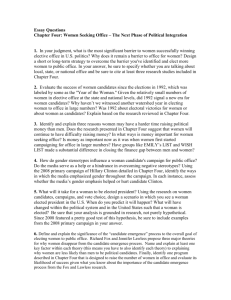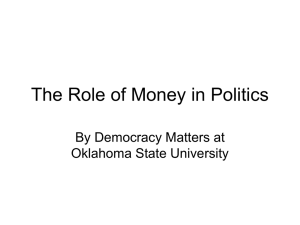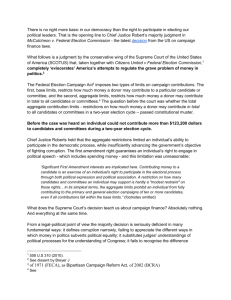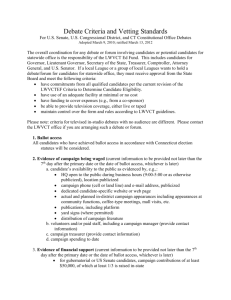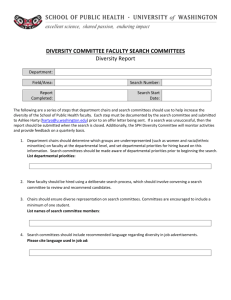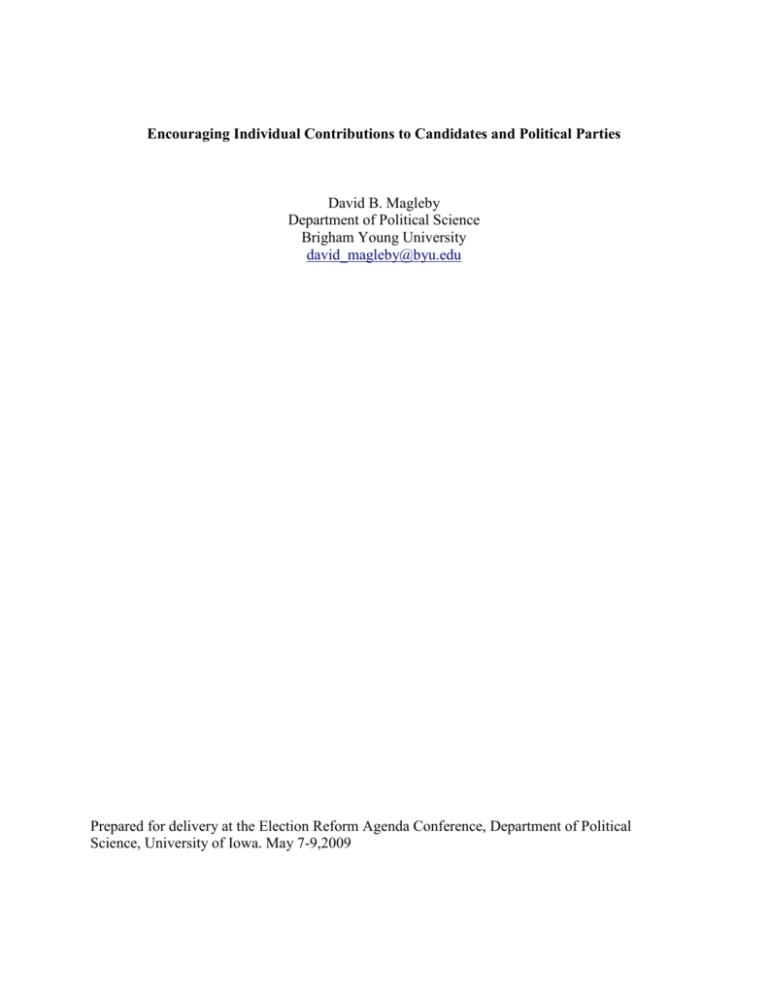
Encouraging Individual Contributions to Candidates and Political Parties
David B. Magleby
Department of Political Science
Brigham Young University
david_magleby@byu.edu
Prepared for delivery at the Election Reform Agenda Conference, Department of Political
Science, University of Iowa. May 7-9,2009
Encouraging Individual Contributions to Candidates and Political Parties
David B. Magleby1
Brigham Young University
The sources of funding for candidates and political parties have long been seen as a
potential source of corruption and therefore subject to government regulation. At the same time
our democracy values freedom of expression and the ability to contribute money to candidates or
political parties has been seen as one means of exercising First amendment rights.
Money given to candidates and party committees can come from multiple sources
including individuals, corporations, labor unions, other organized interests, and the candidates
themselves. In policy and the law the sources of funds have been treated differently.
Individuals, for example, under the most recent campaign finance reforms could give a candidate
for federal office $4,600 in 2007-08 for the primary and general election campaign combined. A
political action committee (PAC), which often represented many individuals, in the same cycle,
could give a candidate for federal office a total of $10,000 for the primary and general election
campaigns. The individual contribution limit for individuals was doubled and for the first time
indexed for inflation in the Bipartisan Campaign Reform Act (BCRA) which passed in 2002 and
took effect in the 2004 election cycle.
BCRA’s authors self-consciously wanted to elevate the role of individuals vis a vis
organized interests, or PACs. “Congressional reformers designed BCRA to sever the link
1
Some of the data reported is drawn from a research project funded by the Pew Charitable Trusts and the Carnegie
Corporation of New York. I gratefully acknowledge the assistance of Bradley Jones, David Lassen, Virginia
Maynes, and Case Wade in preparing this paper.
1
between big soft money givers and elected and party officials, as well as to stimulate growth in
individual contributions by raising contribution limits…”2 It also wanted to restore the sense of
limits on what any given individual or interest group could spend in a particular race.
The courts have also long seen individual donors as less likely to be corrupting of
politicians than organized interests. In its decision on the constitutionality of BCRA it referred
to a series of prior rulings when it said, “Our treatment of contribution restrictions reflects more
than the limited burdens they impose on First Amendment freedoms. It also reflects the
importance of the interests that underlie contribution limits--interests in preventing ’both the
actual corruption threatened by large financial contributions and the eroding of public confidence
in the electoral process through the appearance of corruption.’3 We have said that these interests
directly implicate ‘the integrity of our electoral process, and, not less, the responsibility of the
individual citizen for the successful functioning of that process.'4 . Because the electoral process
is the very ‘means through which a free society democratically translates political speech into
concrete governmental action,’5 contribution limits, like other measures aimed at protecting the
integrity of the process, tangibly benefit public participation in political debate.’”6
Some money from organized groups has for more than a century been seen as
unacceptable to be given to candidates or political parties. Examples of money that may not be
contributed include corporate or union general treasury funds, and money from individuals who
are not U.S. Citizens . The ban on corporate money has been in existence since passage of the
Robin Kolodny and Diana Dwyre, “A New Rule Book: Party Money after BCRA,” in David B. Magleby, Anthony
Corrado and Kelly d. Patterson, eds., Financing the 2004 Election (Washington D.C.: Brookings Institution Press,
2006), 188.
3
National Right to Work, 459 U. S., at 208; see also Federal Election Comm'n v. Colorado Republican Federal
Campaign Comm., 533 U. S. 431, 440-441 (2001) (Colorado II)
4
National Right to Work, supra, at 208 (quoting Automobile Workers, 352 U. S., at 570)
5
Shrink Missouri, 528 U. S., at 401
6
McConnell v. Federal Election Commission, 540 U.S. 93 (2003).
2
2
Tillman Act in 1907,7and the ban on union general treasury funds dates to the Taft Hartley Act in
1947.8
Candidates and political parties have understandably sought to raise the money that was
easiest to raise. For incumbents that has typically been from PACs. In 2006 House incumbents
received 40% of their funds from PACs, as opposed to only 14% for House challengers. Open
Seat Challengers received 25% of their funds from PACs.9 Other ways party committees and
their allied elected official’s bypassed limits on contributions were to create a new category of
money called “soft money.” Modifications to the post-Watergate limits on contributions from
individuals and groups to political party committees were modified in 1979 and in subsequent
FEC rulings to allow unlimited contributions to party committees for “party building purposes.”
By 1996, such “purposes” had come to include candidate specific electioneering, and by 2000
and 2002 more than $500 million in soft money was raised and spent. BCRA effectively banned
soft money and has successfully reoriented candidates and party committees to raising “hard
money” from individuals and groups.
Individuals, groups and party committees all now enjoy a common status in the law
allowing them to spend unlimited amounts for or against a candidate or party as long as that
expenditure is independent. Permitting such independent expenditures was justified by the
courts in its rulings as balancing freedom of speech with the government’s legitimate purpose in
limiting corruption.10 But the level of involvement by individuals in contributing to candidates
and party committees has varied by the level of office being sought, and as noted by the kind of
candidate seeking contributions. But there has been a consistent preference shown for individual
7
34 Stat. 864 (January 26, 1907).
61 Stat. 136 (1947).
9
David B. Magleby et al., Government by the People (New Jersey: Pearson Prentice Hall, 2008), 164.
10
Buckley v. Valeo, 424 U.S. 1 (1976) and Colorado Republican Federal Campaign Committee v. FEC, 518 U.S.
604 (1996) (Colorado I).
8
3
contributions at the federal and state levels. This essay examines the post-BCRA surge in
individual contributions to candidates and party committees, past efforts to encourage individuals
to contribute, and what some of the salutary benefits of this form of political engagement might
be.
The Post-BCRA Surge in Individual Contributions
A legislative intent of BCRA was to direct candidates and party committees more
towards individual donors, especially since BCRA banned party soft money which had come to
be used to promote or oppose particular candidates in competitive federal races. The way BCRA
encouraged a greater emphasis on individual donors was by doubling the individual contribution
limits previously in place under the Federal Election Campaign Act (FECA) and indexing these
higher limits to inflation, something FECA had not done. The most efficient way for party
committees to raise money thus became going after donors who could contribute the maximum
allowable.
This strategy has worked well for party committees and several presidential candidates.
Table 1 presents the total national political party receipts and the receipts from individuals for
the 2000-2008 period.
(Table 1 about here)
4
5
Money raised from individuals represents a very large proportion of all money raised by
party committees. In 2007-08, for example, 88 percent of money raised by the DNC and RNC
came from individuals, while between two-thirds and three-quarters of the money raised by the
DSCC and NRSC came from individuals. A majority of money raised by the DCCC came from
individuals in 2008 and closer to two-thirds of the money raised by the NRCC came from
individuals. In terms of contributions to party committees, PACs and organized interests play a
much lesser role than individuals. This is especially true since soft money was banned by
BCRA. The data reported in Table 1 is only hard money. While party committees have years
that are better or worse than others, the overall trend has been upwards in terms of money raised
from individuals.
To what extent to party committees rely on large vs. small donors? Table 1 provides data
to answer this question. BCRA not only raised the individual contribution limits for money
given to candidates but increased the aggregate contribution limits as well. The aggregate
contribution limit for an individual in 2007-08 was $108,200.11 Within that limit an individual
can only give in the aggregate $42,700 to candidates. The party committees for wealthy donors
thus had an opportunity to raise more money from individuals.
Contributions at the maximum allowed by the law have risen substantially since 2000.
Looking at presidential election years, the DNC raised $11 million in “max out” donations in
2000 that figure rose to $43 million in 2004 and dropped a bit in 2008 to $41 million. The RNC
in 2000 raised $12 million from these “max out” donors , $61 million in 2004 and fell to $37
million in 2008. This decline may reflect the disappointment of major donors in McCain’s
nomination for the presidency. The Democratic congressional campaign committees have
11
Federal Election Commission, FEC Announces Updated Contribution Limits, January 23, 2007,
http://www.fec.gov/press/press2007/20070123limits.html, accessed on May 1, 2009.
6
substantially outperformed their Republican competitors in “max out” fundraising. In 2008 the
DSCC raised $26 million form “max out “donors compared to $12 million at the NRSC, and the
DCCC raised $15.6 million compared to the NRCC’s $2 million.
But what about small donors to the political party committees. This type of donor was
emphasized by the Republicans in the period after passage of FECA and for many years they
outperformed the Democrats among small donors. The data in Table 1 show the t the RNC
retains its advantage among donors giving $200 or less to the party committee, the exception
being 2004. The Democratic Congressional campaign committees, however, now are at or near
parity with the Republicans. The surge in individual contributions to the DNC in 2004 was an
early harbinger of the expanded role small individual contributions would come to play in 2008.
Ellen Moran who ran the DNC independent expenditure operation in 2004] stated that “the surge
in individual contributions to the DNC is particularly striking as it brought ‘three to four times’
more money than expected.”12 While the growth in individual contributions to the political
parties is important and runs counter too many who predicted the demise of the parties with
BCRA’s soft money ban, 13 the surge in individual contributions to the candidates has been even
greater.
BCRA, as noted, provided an incentive for party committees to target donors able to
“max out” to the party committee, and by doubling the individual contribution limit it meant for
people with income sufficient to allow them to give $4,600 to a candidate they now could. But it
did nothing to change the incentives for small donors to give to party committees of candidates.
12
Ellen Moran, DNC, interview by David B. Magleby, Washington D.C., December 16, 2004
Seth Gitell, 2003, “The Democratic Party Suicide Bill,” Atlantic Monthly 292 (1): 106-13; Raymond La Raja,
2008, Small Change: Money, Political Parties, and Campaign Finance Reform (Ann Arbor, MI: University of
Michigan Press); Sidney Milkis, 2003, “Parties Versus Interest Groups,” in Anthony Corrado, Thomas E. Mann, and
Trevor Potter (eds.), Inside the Campaign Finance Battle: Court Testimony on the New Reforms (New York:
Brookings Institution Press).
13
7
Even without changes in the law, small donors have come to be much more important in
presidential campaign finance. The surge in small individual contributions appears to be driven
in part by issues, in part by charismatic candidates who reach particular types of voters and in
part by technology, especially the use of the internet as a means of making political
contributions. There were some early harbingers of this in the 2000 campaign, especially in the
John McCain’s reported fundraising via the internet. The success of MoveOn.org in raising
money especially in 2004 when they raised $21 million, much of it through the Internet,14 and
the Howard Dean’s campaign also in 2004, and were additional early indicators that individuals
would be willing to contribute to candidates and groups via the Internet. When John Kerry
accepted public funding for his general election campaign he invited individuals to give to the
DNC. As shown in Table 1, the DNC in the 2003-04 election cycle raised $166 million in small
contributions from donors who gave $200 or less to the committee. For the first time the DNC
surpassed the RNC in money from donors making contributions at this level.
More than any other candidate, Barack Obama’s campaign was successful in raising
money both from individuals making at or near the “max-out” levels. He received over 50% of
his itemized contributions in amounts over $2,000.15 Obama’s success in raising money,
especially early in the campaign, from individuals making contributions of near the “max out”
level or more was been underreported in the media and provided a needed foundation for his
campaign.
Obama’s extraordinary success in raising money from individuals giving him in the
aggregate $200 or less was unprecedented. The protracted nomination battle helped Obama
MoveOn was created in 1998, in part to get the country to “move on” from the Clinton-Lewinsky and Clinton
impeachment issues. In 2000 it raised $2.3 million for a broader agenda, including advocacy.
15
David Magleby, Bradley Jones, and David Lassen, “Turning the Tables: Individual Contributions, Member
Contributions, and the Changing Campaign Finance Environment,” The Berkeley Electronic Press (2009), 7.
14
8
develop a larger donor base as did his skillful use of technology and creative messaging. Figure
1 provides a graph of the percentage of Obama and McCain’s contributions that did not exceed
the $200 FEC reporting threshold by reporting period.
Figure 1
Small Individual Contributions to McCain and Obama by Reporting Period
Source: Bob Biersack, Deputy Press Officer, Federal Election Commission, email communication
with David Magleby, March 4, 2009.
NOTE: The vertical line near the beginning of September 2008 indicates the approximate date of
the national party conventions.
4
The Obama success in raising money from individuals in small amounts and often over
the internet was not limited to fundraising. Rather the strategy saw giving money as one of many
ways individuals could become engaged in the process. Other modes of participation included
attending events, talking to friends about Obama, volunteering at an Obama office, calling
9
people from a list provided by the campaign writing a blog post, creating internet multimedia,
and joining Obama groups on social networking sites.
Securing contributions from individuals, including many new donors was not isolated to
Obama. Another 2008 candidate who raised substantial sums from individuals, often in small
amounts over the internet was Ron Paul. The Paul campaign generated news coverage, including
coverage on popular media, such as Stephen Colbert, John Stewart, The Ellen Show, The
Tonight Show, with their surprising success in fundraising, what they called “money bombs.”16
What the Paul and Obama campaign had in common was a confidence in the new
technologies, a willingness to decentralize fundraising and invite people to involve others in
financing the campaign. Both candidates started with a strong anti-Iraq war base, a compelling
message, and a young and innovative campaign staff willing to take risks and try new
approaches. Overall Paul raised 61% of his money from small donors, by far the highest
proportion, but others also did well among small donors in the nomination phase of the
campaign: Fred Thompson (43%), John Edwards (36%), Mike Huckabee (35%), and Barack
Obama (32%). It may be the case that other candidates will pattern their fundraising after the
Obama and Paul success stories from 2008, but it may also be beneficial to consider a set of
incentives that could be given to individuals to contribute to candidates or political parties.
Providing Incentives for Individuals to Contribute to Candidates and Political Parties
Public policy often creates incentives for desired behaviors. Examples include favorable
tax status for retirement accounts, college savings accounts, and tax deductibility for home
mortgage insurance or tax credits for insulating homes or buying fuel efficient automobiles. At
the state and national levels, governments over time have experimented with providing
16
Jesse Benton, Director of Communications for Ron Paul Campaign, interview by David Magleby, December 11,
2008.
10
incentives for candidates and party committees to raise funds from individuals and also for
individuals to contribute to candidates or political party committees. This paper is not intended
to be an exhaustive examination of these incentives over time but rather to provide examples of
approaches that might be taken to encourage candidates and party committees with incentives to
raise money from individuals making small contributions and for individuals to contribute to
candidates or party committees.
The current presidential public financing law for the nomination phase is an example of a
law that creates an incentive for candidates to raise money from individuals, and especially from
individuals making contributions of up to $250. 17 For most of the history of the Federal
Election Campaign Act, candidates routinely accepted the public matching funds for presidential
primaries. Before 2004, Candidates who did not participate were Steve Forbes in 1996 and
2000, John Connally in 1980,and George W. Bush in 2000. Since 2000, candidates have been
more likely to not accept the matching public funds but the reasons for that include the state-bystate spending limitations that come with accepting the matching funds, especially with the frontloading of caucuses and primaries meaning candidates must compete in places before they have
received the federal match;18 and the fact that the cost of running has far outpaced the static
amount provided in matching funds.19
Even with these limitations, the matching funds have provided important added revenue
to candidates. Matching funds are sometimes used by the media as a sign of candidate viability.
Finally, as Wayne Steger notes that the most important aspect of matching funds is the spending
17
If the candidate to whom the contribution has been given has raised at least $5000 in at least 20 different states.
William G. Mayer, 2009, “An Incremental Approach to Presidential Nomination Reform,” PS: Political Science
and Politics 42: 65-9.S
19
Anthony Corrado, as quoted in Nelson W. Polsby, Aaron Wildavsky, and David A. Hopkins, 2007, Presidential
Elections (Lanham, MD: Rowman and Littlefield).
18
11
limits that they placed on both weak and strong candidates, helping to level the playing field and
allow dark horse candidates to compete more effectively.20
For individuals, the match provides an incentive to give. It means for up to $250 they
contribute they are doubling their support of their preferred candidate. As with matching
programs in fundraising generally, this often is an incentive to get people to give.21 Neither the
federal government nor the states have extended the match to individuals giving to political
party committees but many of the same motivations for individuals to give may extend to
political parties. Political parties play vital roles in the functioning of our electoral democracy.
They organize the competition, recruit and train candidates, and help voters understand the
choices before them. Extending the match for small individual contributions to political parties
might help build stronger parties and foster greater electoral competition. Thirteen states provide
an income tax check off for parties.22
The federal government for a time and some states continue to provide incentives for
individuals to give to candidates or political parties. FECA, for example, provided a federal
income tax credit for half of the contribution to a candidate. The maximum credit was $12.50 in
1971 and $50 (on a joint return) in 1978. The policy goals of this program were to reduce the
effect of large donors and corporations and increase the role of small, individual donors in the
system.23 This may have encouraged individuals to contribute. There was an increase in money
raised from small donors until the soft money surge came after 1996. The federal income tax
20
Wayne P. Steger, “Do Primary Voters Draw from a Stacked Deck? Presidential Nominations in an Era of
Candidate-Centered Campaigns,” Presidential Studies Quarterly 30 (4): 727-53.
21
Catherine C. Eckel and Philip J. Grossman, 2003, “Rebate Versus Matching: Does How We Subsidize Charitable
Contributions Matter?” Journal of Public Economics 87: 681-703; John A. List and David Lucking-Reiley, 2002,
“The Effects of Seed Money and Refunds on Charitable Giving: Experimental Evidence from a University Capital
Campaign,” Journal of Political Economy 110 (1): 215-33.
22
The states are: Alabama, Arizona, Idaho, Iowa, Kentucky, Maine, Minnesota, New Mexico, North Carolina, Ohio,
Rhode Island, Utah, Virginia.
23
Thomas E. Mann, 2003, “Linking Knowledge and Action: Political Science and Campaign Finance Reform,”
Perspectives on Politics 1: 69-83.
12
credit for individual contributions was abolished in 1986 as part of Ronald Reagan’s overhaul of
the tax code, with the stated purpose to reduce tax shelters and simplify the overall system.
One problem with the tax credit is that the donor does not receive the reimbursement on
the contribution until taxes are paid in the following year. Minnesota has a program which
provides a more immediate contribution refund. The program allows individuals who have
donated to candidates and parties who agreed to limit expenditures to file for an immediate
refund of their contribution. The maximum refundable amount is $50 for individuals and $100
for couples.
Political Scientists Robert G. Boatright, Donald P. Green, and Michael J. Malbin
conducted experiments on tax credit programs in Ohio in the 2002 election cycle. They sent
mailers to individuals to encourage them to take advantage of the Ohio law that permits a $50 tax
credit to those who contribute to state candidates. They found a modest increase in giving that
seemed to come from the added information. They continue, “even a small increase in the pool
of small donors can yield significant overall effects.24
Some contend that tax credits should be reintroduced as a way to increase individual
giving. David Rosenberg, whose 2002 book Broadening the Base discusses this topic
extensively, argues that tax credits for political contributions are one of the fundamental
approaches to reform overlooked by , BCRA’s sponsors. Rosenberg posits that “a well-crafted
tax credit for political contributions can be a cost-effective and sound method for helping balance
the influence of big money donors in the American electoral process.” He also asserts that tax
credits “encourage many candidates to seek the small, local contributions that are almost
universally valued in our political system.”25
Robert G. Boatright, Donald P. Green, and Michael J. Malbin, “Does Publicizing a Tax Credit for Political
Contributions Increase its Use?: Results from a Randomized Field Experiment” American Politics Research 34
(2006) 578.
25
David Rosenberg, 2002, Broadening the Base: The Case for a New Federal Tax Credit for Political
24
13
Encouraging Political Contributions as a Means of Fostering Greater Political Engagement
Contributing money to a candidate or political party is only one form of political
engagement. Does contributing more money to candidates or political parties foster other forms
of political engagement like higher turnout, greater interest in elections and politics, or in
engaging in other forms of volunteer activity like working on a campaign, persuading others to
vote, or helping a party to more effectively communicate with citizens.
Past donor studies have shown a significant correlation between donors to political
campaigns and other types of political behavior, but it remains unclear whether donating causes
individuals to become more “invested” in the process? Or is it just that those already invested in
the process donate? Indeed, a good amount of scholarship has gone into what Schattschneider
might have described today as the “upper-class accent” of the donor population. If those who
give to campaigns are systematically different from the general populace, are the uncharacteristic
opinions of a minority shifting public opinion in the wrong direction?
In studies my colleagues and I are doing on 2008 we hope to explore the relationship
between giving money to a party or candidate and other forms of engagement. Those who
contribute are likely already predisposed to participate but in 2008 the numbers of young and
possible not previously fully engaged voters is such that we may learn more about the positive
benefits of contributing money. It may also the case that participation in ways other than giving
money helps individuals to decide to give money.
Contributions (Washington, DC: American Enterprise Institute).
14
Conclusion
The marriage of the Internet, candidate appeal, issues, and effective messaging in 2008
helped propel Barack Obama to record setting levels in individual contributions. There appear to
have been benefits to the campaign from individuals not only giving money but becoming more
engaged in other ways as well. It is not clear that what happened in the Obama campaign is
applicable to candidates seeking other offices but it may be, especially if candidates and party
committees could offer incentives to people to make contributions. As the Obama campaign
apparently discovered, once a person has given the campaign can engage them in other activities
and often in making additional contributions.
Encouraging individuals to contribute to candidates and political parties is important as
our electoral democracy requires resources. The hopeful lessons of 2008 suggest that fostering a
culture of individuals investing in candidates and parties can yield additional benefits to our
political system. At a minimum we should encourage wider experimentation with different types
of incentives and also invest in public information campaigns so people understand the program
and its benefits.
15


